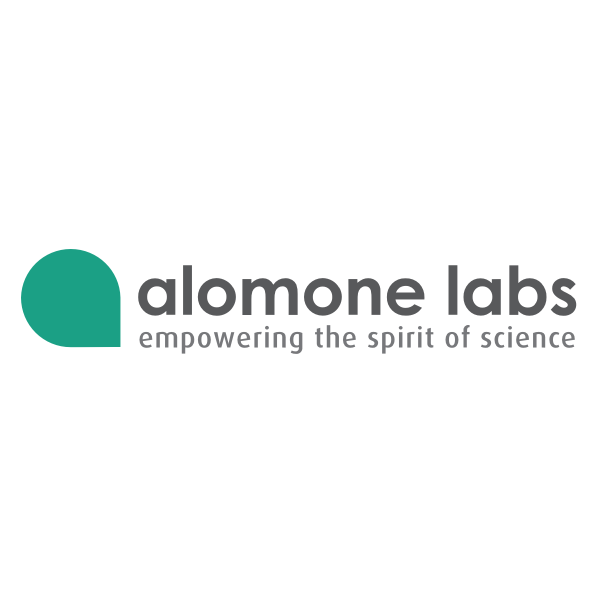 全部商品分类
全部商品分类
产品介绍
产品介绍
产品信息
纯化方式
Affinity purified on immobilized antigen.

宿主
兔

免疫原
Peptide (C)KELVKNYNPLER, corresponding to amino acid residues 31-42 of rat nAChRα7 (Accession Q05941). Extracellular, N-terminus.

简单描述
A Rabbit Polyclonal Antibody to Nicotinic Acetylcholine Receptor α7

商品描述
Anti-Nicotinic Acetylcholine Receptor α7 (CHRNA7) (extracellular) Antibody (#ANC-007) is a highly specific antibody directed against an epitope of the rat protein. The antibody can be used in western blot, immunohistochemistry, immunocytochemistry, live cell imaging, and indirect flow cytometry applications. It has been designed to recognize nAChRα7 from mouse, rat, and human samples.

同种型
Rabbit IgG.

纯度
Affinity purified on immobilized antigen.

形式
Lyophilized

组成成分
烟碱型乙酰胆碱受体抗体;磷酸盐缓冲液;防腐剂(0.05%叠氮化钠溶液)

基因
CHRNA7

应用
实验应用
ICC, IF, IFC, IHC, LCI, WB

反应种属
H, M, R

背景
别名
nAChR α7, Cholinergic receptor nicotinic alpha 7, Neuronal acetylcholine receptor subunit alpha-7, ACRA7

背景
Acetylcholine, released by cholinergic neurons, activates two groups of acetylcholine receptors (AChRs); muscarinic AChRs (mAChRs) which belong to the superfamily of G-protein coupled receptors (GPCRs) and nicotinic AChRs (nAChRs) which belong to the ligand-gated ion channel superfamily. nAChRs also respond to nicotine, hence their name1. These channel receptors are usually non-selective cation channels activated upon ligand binding which ultimately leads to the depolarization of postsynaptic cell membranes.
To date, 17 different but related subunits of nAChRs have been identified and cloned. They consist of a subunits (α1-10), which is responsible for the binding of ligands. In fact, this subunit includes a Cys-loop in the first extracellular domain that is required for agonist binding2. The other subunits responsible for making up the active receptor are the β (β1-4), γ, δ and ε subunits3. Structurally, all subunits have the following: a conserved large extracellular N-terminal domain, 3 conserved transmembrane domains, a variable cytoplasmic loop and a fourth transmembrane domain with a short extracellular C-terminal domain. An active nAChR is generally a heteropentamer (homopentamers also exist) of these various subunits organized around a central pore1. However, the α7 subunit mainly forms homomeric functional structures, although functional channels have been observed with its association with α5, β2 or β3 subunits1.
Interestingly, the α7 nAChR is the only subunit to be activated by two endogenous ligands: acetylcholine and choline1.
All α subunits are expressed in neuronal cells except for the α1 subunit which is specifically expressed in skeletal muscle. They are also expressed in non-neuronal cells such as bronchial epithelial cells4, as well lymphocytes5. The diversity of these receptors and their functional organization gives rise to unique properties and functions. The α4β2 receptor composition makes up a high affinity nicotinic receptor. In fact, its upregulation (mainly expressed by the increase of functional receptors at the membrane and not expression per se) is responsible for the increased appearance of binding sites following nicotine administration1,3.
α7 nAChR seems to be involved in the impairment of sensory gating in schizophrenic individuals. Indeed, many polyphormisms have been detected in the gene promoter of the receptor6. There is also an association of the receptor with nociception as it, along with α2 and α10 subunits are expressed in DRGs, the nociceptive center7.
To date, 17 different but related subunits of nAChRs have been identified and cloned. They consist of a subunits (α1-10), which is responsible for the binding of ligands. In fact, this subunit includes a Cys-loop in the first extracellular domain that is required for agonist binding2. The other subunits responsible for making up the active receptor are the β (β1-4), γ, δ and ε subunits3. Structurally, all subunits have the following: a conserved large extracellular N-terminal domain, 3 conserved transmembrane domains, a variable cytoplasmic loop and a fourth transmembrane domain with a short extracellular C-terminal domain. An active nAChR is generally a heteropentamer (homopentamers also exist) of these various subunits organized around a central pore1. However, the α7 subunit mainly forms homomeric functional structures, although functional channels have been observed with its association with α5, β2 or β3 subunits1.
Interestingly, the α7 nAChR is the only subunit to be activated by two endogenous ligands: acetylcholine and choline1.
All α subunits are expressed in neuronal cells except for the α1 subunit which is specifically expressed in skeletal muscle. They are also expressed in non-neuronal cells such as bronchial epithelial cells4, as well lymphocytes5. The diversity of these receptors and their functional organization gives rise to unique properties and functions. The α4β2 receptor composition makes up a high affinity nicotinic receptor. In fact, its upregulation (mainly expressed by the increase of functional receptors at the membrane and not expression per se) is responsible for the increased appearance of binding sites following nicotine administration1,3.
α7 nAChR seems to be involved in the impairment of sensory gating in schizophrenic individuals. Indeed, many polyphormisms have been detected in the gene promoter of the receptor6. There is also an association of the receptor with nociception as it, along with α2 and α10 subunits are expressed in DRGs, the nociceptive center7.

制备和贮存
溶解方法
25 μl, 50 μl or 0.2 ml double distilled water (DDW), depending on the sample size.

保存方式
The antibody ships as a lyophilized powder at room temperature. Upon arrival, it should be stored at -20°C.
数据库链接
Entrez-Gene ID
25302

UniProt ID
Q05941

研究资源识别码
AB_10659339.

声明 :本官网所有报价均为常温或者蓝冰运输价格,如有产品需要干冰运输,需另外加收干冰运输费。









 用小程序,查商品更便捷
用小程序,查商品更便捷




